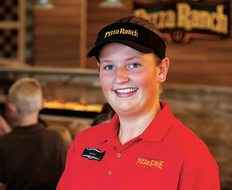The quick-service industry is notorious for its 100-percent-plus turnover levels. But with the costs of hiring and training new employees—both in money and time—stealing precious resources away from operators in a still-lagging economy, many are relying on employee incentive programs to keep their crew around.
Many operators are finding that such programs can address not just turnover, but also a range of personnel issues, such as attendance problems, customer service levels, and even average ticket size.
One popular way to encourage store employees to be consistently sharp, experts say, is the tried-and-true mystery shopper. The program is widely used by quick serves, but it’s how companies structure the rewards that determines long-term success.
“We use the information gathered from our third-party mystery shoppers to create weekly, monthly, and quarterly rewards programs for our hourly level staff members,” says Molly Catalano, director of communications and marketing at Lorton, Virginia–based Five Guys Burgers and Fries. “We reward the top 200 restaurants in the system for that week.”
Catalano says the weekly reward is anywhere from about $900 to $1,300 per store. “That money is split amongst the people working when they were mystery shopped, and there’s a chance to win every week,” she says.
Incentive programs such as the one at Five Guys, with short durations and multiple chances for rewards, are built on a foundation that responds to human instinct, says Robert Cowen, a representative and advisor at Snowfly Incentives Inc., which helps companies in a variety of industries design and implement successful incentive programs. He calls it “rewarding the daily homework,” and uses attendance-improvement programs as an example.
“If you have an attendance reward for perfect monthly attendance, but a week into it someone has an absence, you have lost complete leverage on that individual to try to make them do what you want them to do for the remainder of the month,” Cowen says. “They give up and stop trying.” To combat lagging performance once a goal has been missed, Cowen says, incentive programs should be structured on small, recurring time increments.
But motivating store managers, whose responsibilities and level of accountability are greater than that of hourly employees, requires a different approach. At Pizza Ranch, incentives on the store-management level are crucial to the chain’s success.
“We call our managers multipliers—they take whatever we do and they multiply the effect of it,” says Jon Moss, COO at Pizza Ranch. “Anything we can do to recognize outstanding performance in managers, I believe that has a disproportionately positive result in our stores.”
Measured metrics in the Pizza Ranch Manager Rewards program include store-level profitability, same-store sales numbers, and secret-shopper performance. Each year, the program identifies the top 30 percent of operators in the 157-unit chain, who are then treated to an all-inclusive trip to a tropical destination.
“One of the positives we see as the franchisor, at our level and in the stores themselves, is this group’s unity,” Moss says. “They can hang out together—we do very little business on the trip—and it really is a reward for them. We don’t make them sit in three days of meetings.” Moss says the chance to unwind as a team also creates good harmony within the organization.
The amount spent on incentive programs varies widely, and may be gauged against total payroll spend, advertising budgets, and systemwide profitability, experts say. While cash and prepaid debit cards remain among the most popular rewards, Cowen says, a variety of nonfinancial incentives can also be strong motivators.
“One of the best ones in this market is choice of shift and choice of station,” he says. “Preference on schedule or station can be critical in terms of what’s going on.” Other less tangible rewards, such as extra breaks and extra meals, which cost very little overall, may also be good options, Cowen says.
Pizza Ranch gives an unusual noncash perk to its Crew of the Year: a pair of custom-designed Nike shoes for every crewmember in the winning store.
“It doesn’t matter if the store has 20 employees or 80 employees, every single team member gets one,” Moss says. “[They] make it personal to their store, and then everybody in the store gets that version.” Additional store-level rewards at Pizza Ranch include retail-outlet gift cards and even partial college scholarships. The company also utilizes its NASCAR partnership with Joe Gibbs Racing to feature the winning store on the racecar and provide employees with VIP access to races.
Company or even individual store culture may play a role in finding noncash rewards that motivate workers, the experts say. “Our franchisees do many nonfinancial incentives,” Catalano says, “and I think that those are effective because they are customized by store. The franchisee really knows what will motivate his or her crewmembers.”
Cowen says offering rewards that your employees actually want is fundamental to program success. “Nothing is worse than getting an envelope that has something in it that you don’t want,” he says.
In addition to reducing employee turnover at the store level, Pizza Ranch’s metrics improved in other areas, too, Moss says.
“We looked at manager retention. Had that improved? It had. We looked at guest satisfaction scores. Had they improved? They had,” Moss says. Any restaurant company can have similar success, he says, “if they’re focusing on their people.”
The team at Five Guys has also seen positive results. “We think that our success can be seen in the increase in mystery-shopper-score average over time, in the satisfaction of our employees, and in our growth as a company,” Catalano says. “We have seen success in all three areas.”
But Catalano cautions that the improvements come with a caveat. “Other companies could definitely do it, but it takes a lot of work,” she says. “There’s a lot of administrative backend, and we need a lot of buy-in and support from franchisees.”













